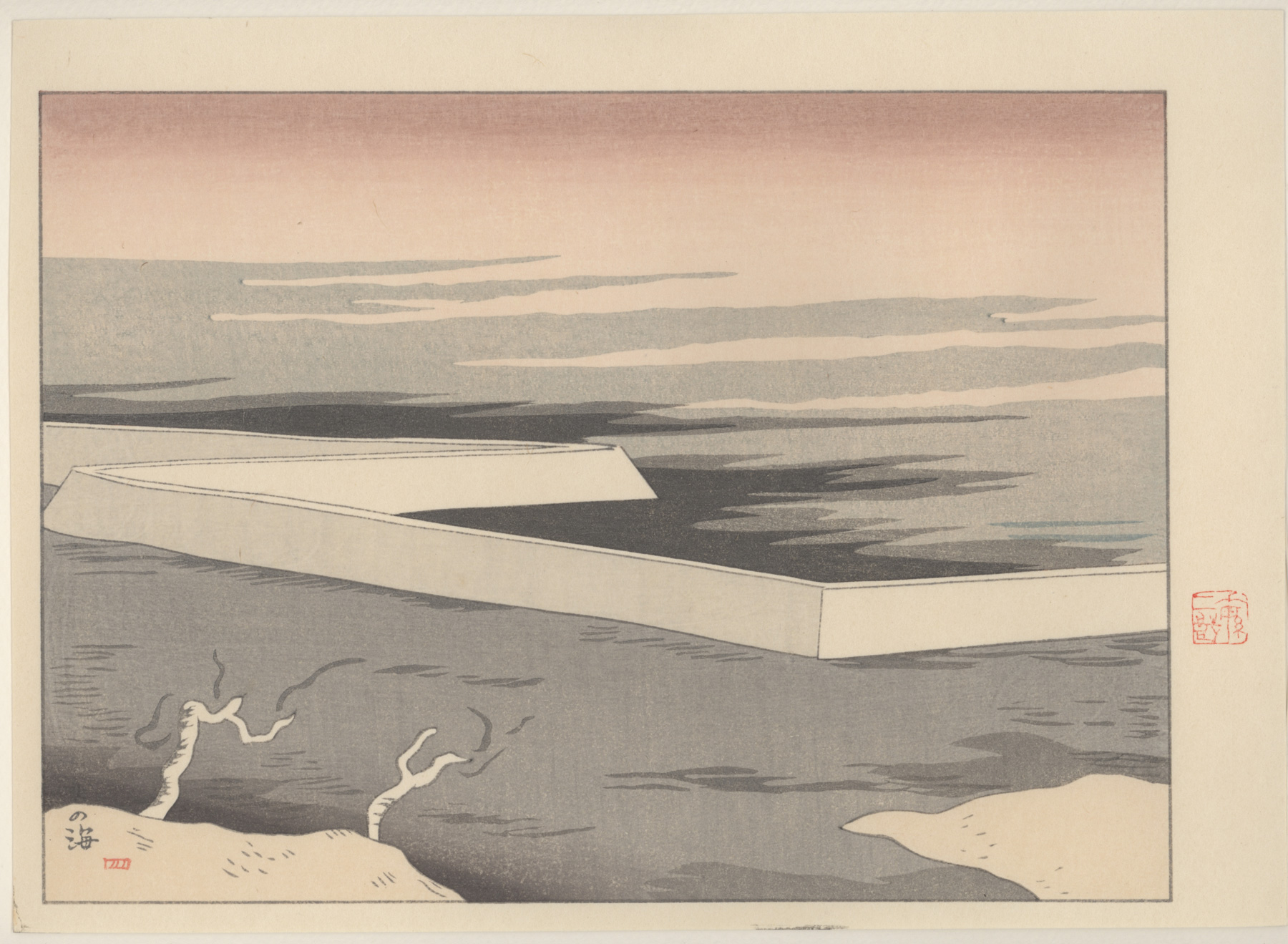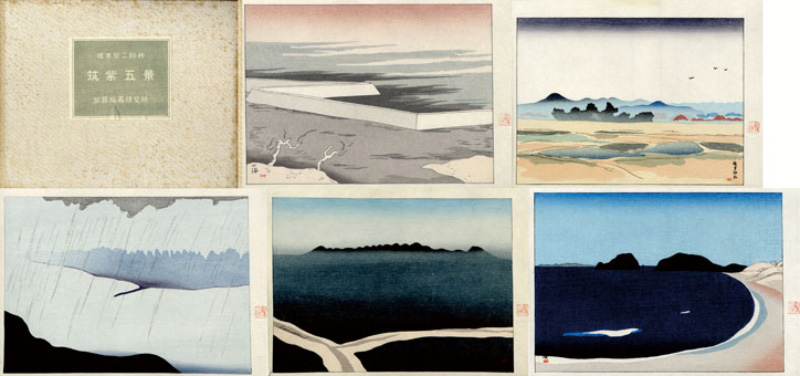About This Print
This print by Sakamoto Hanjirō, picturing the ancient fortifications along Hakata Bay, is a 1970 reissue of a print originally released in 1918. (See IHL Cat. #862 for the original 1918 print and a comparison of the 1918 with the 1970 print.) Originally the print was published by Nakajima Jūtarō and the Japan Scenery Prints Association as part of the a set of five prints titled Tsukishi District which was part of the 10 set series titled Japan Scenery Prints. In 1970, the publisher Katō Junji reissued the five scenes of Tsukushi under the title Five Scenes of Tsukushi [筑紫五景 Tsukushi Gokei]. New printing blocks were very carefully recarved for this reissue, resulting in prints that closely match the 1918 releases.
For images of the original prints and the reissued prints, see the images below.
Source: Modern Japanese Woodblock Prints - The Early Years, Helen Merritt, University of Hawaii Press, 1998, p. 276.
"Sakamoto Hanjirō's, Sea of Fire, 1918, from Set Number Six on the Tsukishi district is simple and elegant. It represents the remains of the stone walls along Hakata Bay which were erected after the first attempted Mongol invasion in 1274. When the Mongols attacked a second time in 1281 they were unable to penetrate the wall and were ultimately defeated by a devastating typhoon which set fire to their ships. Sea of Fire refers to the raging fires in the bay."
Notes by Lawrence Smith on the Original Series "Japan Scenery Prints"
Source: Modern Japanese Prints 1912-1989, Lawrence Smith, British Museum Press, 1994, p. 42.
"Tsukushi is the ancient name of the area north-west of Kyushu [in the area of Chikuzen and Chikugo provinces] where Sakamoto was born. Sakamoto was rarely involved with sheet-prints, but like his colleagues on this series he had worked as a cartoonist and illustrator and had been a collaborator on the magazine Hōsun hence he was well used to graphic techniques. Indeed, his set [Tsukushi district] is the most strikingly designed in the series, combining impressionist, abstract and Expressionistic elements into a characteristically forceful blend."
Print Details
| IHL Catalog | #1392 |
| Title |  Title as given in table of contents for 1918 first edition: 火の海 ひのうみ [Hi no umi - Sea of Fire] Subtitle as given in table of contents for 1918 first edition: 沖の端より望む おきのはたよりのぞむ |
| Series | Five Scenes of Tsukushi [筑紫五景 Tsukushi Gokei] |
| Artist | Sakamoto Hanjirō (1882-1969) |
| Signature | unsigned |
| Seal |  |
| Publication Date | 1970 |
| Edition | second |
| Publisher |  originally by Nakajima Jūtarō 中島 重太郎 of the Japan Scenery Prints Association 日本風景版画会 |
| Carver | |
| Impression | excellent |
| Colors | excellent |
| Condition | excellent - tipped into original presentation folder |
| Genre | sosaku hanga (creative print) |
| Miscellaneous | |
| Format | chuban |
| H x W Paper | 7 5/8 x 10 1/2 in. (18.1 x 26.7 cm) |
| H x W Image | 6 3/4 x 9 5/16 in. (17.1 x 23.7 cm) |
| Collections This Print | Carnegie Museum of Art 89.28.116.3 (1918 release) |
| Reference Literature | Guide to Modern Japanese Woodblock Prints: 1900-1975, Helen Merritt, University of Hawaii Press, 1992, p. 264-265; Modern Japanese Woodblock Prints - The Early Years, Helen Merritt, University of Hawaii Press, 1998, p. 275; Modern Japanese Prints: The Twentieth Century, Amanda T. Zehnder, Carnegie Museum of Art, 2009, p. 155; Images of a Changing World: Japanese Prints of the Twentieth Century, Donald Jenkins, Portland Art Museum, 1983, p. 68. |




